
Research Article
Ann Materials Sci Eng. 2024; 8(1): 1051.
Influence of Non-Cohesive Soils with Induced Structural Heterogeneities on Internal Erosion Due to Suffusion
Ouaga Jean-Bruce Gboga; Athanas Konin*
Civil engineering laboratory, Institut National Polytechnique Félix Houphouët-Boigny (INP-HB), BP 1093 Yamoussoukro, Ivory Coast
*Corresponding author: Athanas Konin Civil engineering laboratory, Institut National Polytechnique Félix Houphouët-Boigny (INP-HB), BP 1093 Yamoussoukro, Ivory Coast. Email: athanas.konin@inphb.ci
Received: June 11, 2024 Accepted: July 03, 2024 Published: July 10, 2024
Abstract
This paper presents an experimental study focused on the behavior of non-cohesive soils presenting structural heterogeneities subjected to internal erosion due to suffusion. The suffusion tests were performed by applying a downward seepage flow under multi-staged hydraulic gradient. Experiments were carried out at the scale of a soil sample. Soil samples with structural homogeneity and soil samples with structural heterogeneities were tested. Homogeneous soil samples were used for comparison. Two heterogeneity configurations based on fines content (15% and 25%) and density index (ID = 0.1 and ID = 0.4) were tested. measurements of flow velocity, total eroded mass and erosion rate were carried out.
The analysis of results obtained has shown that soils with induced structural heterogeneities are more erodible than soils with homogeneous structure, independently of the fines content and the density index. The specimens with low density index (ID = 0.1) are more erodible than those with medium density index (ID = 0.4).
Introduction
Earthen hydraulic structures, such as dams and dikes, present a high risk of failure due to internal erosion. According to Foster et al. [1], 46% of embankment dams failure is due to internal erosion. Moreover, during ERINOH project [2], it was shown that internal erosion is the main mechanism of failure of embankment dams. In addition, these structures were mostly built based on the hypothesis of homogeneity of soil layers [3-6]. However, earth dams sometimes present heterogeneities created during their construction due to particle segregation or during their rehabilitation/reinforcement due to the addition of new soil layers to existing ones [7]. The study of the effect of soil heterogeneity on internal erosion therefore appears to be essential to better understand and predict the behavior of earthen hydraulic structures.
Thus, several research on suffusion based on laboratory tests have been carried out by subjecting soil samples to different levels of hydraulic gradient under ascending or descending water flows [8-13]. The main results highlighted the impact of different factors on the internal stability of soils, such as geometric conditions (granulometric distribution, grain size, constrictions size, etc.) and hydraulic conditions (hydraulic gradient, direction of flow, etc.). Most of this research has focused on homogeneous samples.
Few research has been devoted to studying the influence of soil structural heterogeneity on suffusion. Luo et al. [14] carried out laboratory tests to study the influence of discontinuous grain size gravel in a soil layer on the suffusion process. The results showed that the presence of gravel in the soil led to a significant reduction in the hydraulic gradient, and an increase in soil porosity. This facilitated the migration of fine particles. Oueidat et al. [15] studied the effects of structural heterogeneity and fine particles content of soil on suffusion initiation. The results showed that the central heterogeneity configuration (coarser particles in the middle of the sample) is more susceptible to suffusion than the downstream one (coarser particles in the lower part of the sample). Deng et al. [16] investigated the internal erosion of gap-graded sandy gravels with different gap ratios, fines contents, and coarse particle morphologies. They founded that increasing the gap ratio could reduce the internal stability of soil and promote the mechanical instability. Fines content affected the permeability and internal stability of soil by altering the filling state of inter-granular pores and the constraints on fine particles.
This paper aims to investigate the influence of non-cohesive soils with induced structural heterogeneities subjected to internal erosion due to suffusion. To do this, homogeneous soil samples and soil samples with structural heterogeneities are tested.
Materials and Methods
Characteristic of Tested Soils
The tested soil samples consisted of Hostun sands commonly used in erosion tests [13,17]. Two types of Hostun sands served as basic material were used to prepare homogeneous and heterogeneous specimens. Sand 1 (fine fraction) noted HN34, is composed of particles with a diameter less than 500 mm. Sand 2 (coarse fraction) noted HN1/2.5, is made up of particles with a diameter greater than 800 mm. The particle size distribution curves are given in Figure 1 and their characteristics in Tables 1.
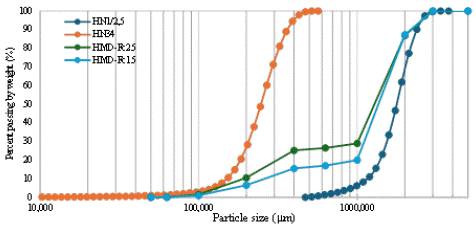
Figure 1: Particles size distribution curves of basic material and reconstituted samples.
Suffusion Apparatus
Figure 2 shows the photograph of suffusion column apparatus used in this study. This large-scale high-pressure erosion apparatus was specially designed for the internal erosion study of non-cohesive soil under vertical seepage flow [13,18]. It is composed of a permeation box, a surcharge pressure loading system, a water supply system, an eroded soil collection system, and a hydraulic gradient and pressure measuring system.
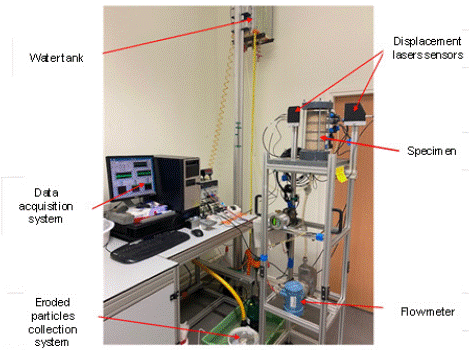
Figure 2: Photo of suffusion column experimental apparatus.
Three hydraulic pressure sensors (P<1
, P2 and P3 shown in Figure 3) were installed up along the suffusion cell to assess the hydraulic conductivity in relation with fine particle migration within the granular structure. These sensors were distant 100 mm apart. The sensors used were BTE6001G4 brand, with an accuracy of 0.1% and operational over a pressure range 0 to 100 kPa. With a data acquisition unit composed by a data acquisition module connected to a computer, pressure, water flow and turbidity data were collected (Figure 2). The computer was equipped with the LABVIEW software. The data module was composed by a mass flowmeter of 2720 Kg/h with an accuracy of 0.5% and an Anderson-Negele turbidimeter, type ITM4 of 5000 NTU.
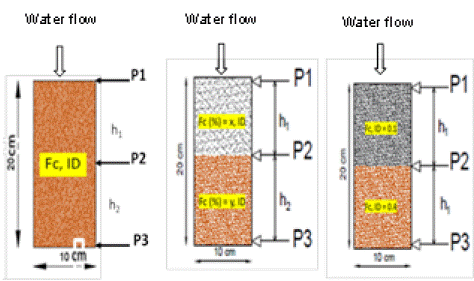
Figure 3: Configuration of studied specimens. (a) Homogeneous sample considered as control specimen; (b) Fine particle content heterogeneity (Fc); (c) Compaction heterogeneity (ID).
Specimen Preparation and Instrumentation
Three types of samples were studied:
- Homogeneous specimen used as reference ones (Figure 3.a);
- Heterogeneity Type 1 (Figure 3.b): consisting of two soil layers with different fines content and the same density index (the density index (ID) also called relative density in literature [19], is the measure of compaction quality of non-cohesive soil). The upper layer was composed by 25% of fine particles while the lower layer was composed by 75% (the fine fraction (Fc) in the granular structure is the total fines content of the sample taken equal to 15% and 25% during the test). The calculation of the fines’ fractions (Fc1 (upper layer) and Fc2 (lower layer)) of the sample is developed below. Either:
Fc: total fraction of fines,
Mft: mass of fine particles,
Mgt mass of coarse particles,
the mass of fine particles in the upper layer (C1) is:
and that in the lower layer (C2) is equal to:
The fraction of fines of the different layers is given by the relationships:
Table 2 gives the fines fractions of the different constituent layers of the sample.
- Heterogeneity Type 2 (Figure 3.c): composed of two layers with the same fines content and different density index (ID = 0.1 for the upper layer and ID = 0.4 for the lower layer, noted ID10/40).
- The experimental steps consisted of preparing homogeneous or heterogeneous samples in a suffusion cell of 100 mm-diameter and 200 mm-height. During internal suffusion test, this cell was filled, as shown in experimental configuration (Figure 1), with the different samples and then submitted to different hydraulic stresses by application of hydraulic gradient.
The total height of the suffusion cell was 234 mm including 17 mm on either side of the central part. The 17 mm were added for balls and meshes which constituted the upper and lower bases of the experimental device. The upper base is constituted by 4 mm-diameter balls inserted between two meshes for good distribution of the fluid over the entire surface on the sample. The lower base is made up by a 10 mm-thick beads and the constriction is calculated according to the Silviera principle [20] to avoid the accumulation of fine particles. The meshes of the lower grid (acting as a filter) in contact with the sample have an opening of 600 mm in diameter to only allow erosion of particles of with a maximum diameter of 500 mm.
The reconstituted homogeneous samples are noted H-FcX-IDY where H stands for homogeneous, FcX represents for X% of fine fraction and IDY stands for Y% of density index. For the reconstituted heterogeneous samples, the notation is Ti-FcX-IDY. The reconstituted samples subjected to the experimental tests are indicated in table 3.
Experimental Procedure
According to Fell and Fry [21] reported by Rochim et al. [22], three criteria are distinguished for suffusion to occur: (1) the size of the fine soil particle must be smaller than the size of the constrictions between the coarser particles, which form the basic skeleton; (2) the volume of fine soil particles must be less than the volume of voids between coarser particles and (3) the velocity of flow through the soil matrix must be high enough to move the loose fine soil particles through the pore.
For this, the test was carried out in three steps: (1) water saturation of the samples, (2) the internal erosion test, (3) analysis of the particle size distribution of the sample. During the first step, carbon dioxide was first injected into the samples under a pressure of 15 kPa for 30 min to purge the trapped air and ensure a high degree of saturation. Then, water is added upwards for 30 min under a low hydraulic gradient (i = 0.05 m/m) to avoid a change in the granular structure.
Sample preparation consisted in mixing the two types of sand (HN34 and HN1/2.5) in different proportions by adding 9% of mixing water. This mixture is then placed in a rotary mixer for two minutes.
When placing the sample in the cell, to reach the target density index, the total mixed wet mass was divided into ten equal mass fractions for a height of 2 cm. Each fraction of elementary mass has been compacted to reach the predefined density and maintain the height of 2 cm.
The suffusion test consisted in subjecting the samples to a downward flow of water at different hydraulic gradients (from 1 to 6), each kept constant for 60 minutes. For these tests, two proportions of fine fraction (15% and 25%) and two values of the density index 0.10 (represent by ID10) and 0.40 (also represent by ID40) were considered.
The measured data were the mass of eroded soil, the hydraulic pressure near the cell wall, and the water flow rate. At the end of the tests, a particle size analyses of the samples were carried out.
Results and Discussion
Effect of Structural Heterogeneities on Flow Velocity
The application of hydraulic gradient at different stages (ranging from 1 to 6) on the samples tested induces flow velocity between 1.30 and 3.50 mm/s during the suffusion tests (Figure 4).
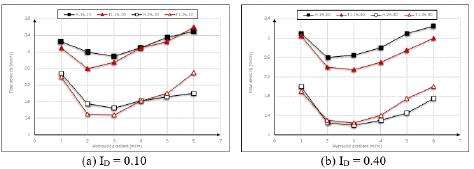
Figure 4: Flow velocity versus hydraulic gradient.
The results presented in Figure 4 show three phases of evolution of the flow velocity. The first step corresponds to a drop in the flow velocity between the first level and the second level of loading for all samples tested. For example, it increases respectively from 3.4 mm/s to 2.9 mm/s then from 3.0 mm/s to 2.6 mm/s for the homogeneous and heterogeneous very loose sand samples respectively (Figure 4a).
In addition, homogeneous specimens have higher flow velocities than those of heterogeneous ones, and therefore the flow of the granular structure is well governed by the less porous layers. Then, between the 2nd level and the 3rd loading level, the speed decreases more slowly, or stabilizes. Finally, during the last stages (4th, 5th, and 6th), the flow velocity increases.
These results can be explained as follows: at the 1st loading level (i = 1 m/m), there is a rearrangement of the particles (contraction, retention, clogging, etc.), which induces a decrease in the flow velocity. Particularly, the clogging phenomenon occurs quickly leading to a reduction in hydraulic conductivity as shown by Reddi et al. [23] in their works. After a certain stabilization for levels i = 2 m/m and i=3 m/m, the flow velocity increases during the last stages due to the space left by the plucking of fine particles with the application of higher hydraulic gradients. The successive gradients cause unblocking forces necessary for the migration of fine particles in the pore network.
Furthermore, it is noted that the flow velocity is higher in soils with a low fraction of fines (a variation of 10% to 90%), and medium dense specimens (ID = 0.4) have lower flow velocities than very loose specimens (ID = 0.1). Similar observations are made by Chang and Zhang [24] and Zhou et al. [25] on reconstituted samples. According to these authors, the behavior of granular soils subjects to hydraulic gradients, (1) decreases with the capture of fine particles in the lower layers which also corresponds to the filling of voids by coarse particles and (2) increases due to the loss of fine particles. These observations are also made by Tomlinson and Vaid [26].
Effect of Structural Heterogeneities on Total Eroded Mass
Case of the Type 1 Heterogeneity: Evolution of the total eroded mass during the suffusion test is presented in Figure 5. The eroded mass increases with the hydraulic gradient applied for all samples, whatever the density index (Figure 5a & Figure 5b). It also increases with the initial proportion of erodible fines (15% and 25%).
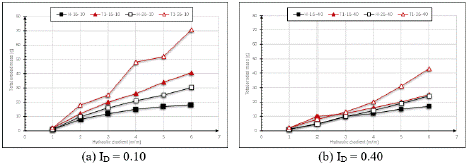
Figure 5: Total eroded mass versus hydraulic gradient – type 1 heterogeneity.
It can be noted that, for a density index ID = 0.1, heterogeneous specimens T1-25-10 and T1-15-10 lost at the end of the test, a mass of 70.7g and 40.6g compared to 30.4g and 18.2g for homogeneous specimens H-25-10, and H-15-10 respectively.
The mass of eroded particles is therefore greater for type 1 heterogeneous specimens than that of homogeneous ones. This can be explained by the presence of a greater quantity of erodible fines in the lower layer of the heterogeneous specimens (75% of the total fines mass).
However, a reduction in the eroded mass is observed when the density index increases from 0.1 to 0.4; this decrease is more than 39% for heterogeneous samples (containing 25% of erodible fines) and approximately 21% for homogeneous ones (with 25% erodible fines). This drop in eroded mass with the increase in the density index could be due to the reduction in pore space locally inducing clogging phenomena.
These results are consistent with those presented by Deng et al. [27]. Indeed, the authors affirm that a high density has a significant influence on the eroded mass for reconstituted sand mixtures.
Case of the Type 2 heterogeneity: Figure 6 shows an increase in eroded mass with hydraulic gradient for all specimens tested. Indeed, the eroded masses at the end of the tests are respectively 13.6g, and 13.7g for type 2 heterogeneous specimens T2-15-10/40 and T2-25-10/40, and 23.7g and 16.5g for homogeneous samples (medium dense sand) H-25-40, H-15-40. We also note that the eroded masses of the type 2 heterogeneous specimens T2-25-10/40 and T2-15-10/40 are less significant than those measured for the homogeneous specimens H-25-40 and H-15-40.
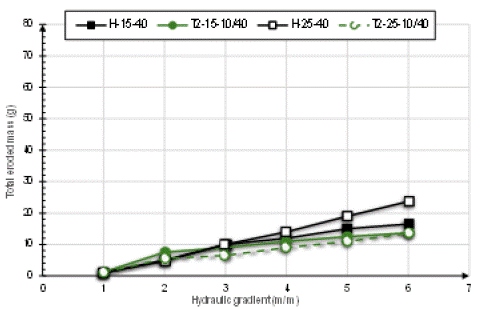
Figure 6: Total eroded mass versus hydraulic gradient – type 2 heterogeneity.
These results can be explained by the filtration effect of fine particles from the upper layer (ID = 0.1) by the lower layer (ID = 0.4) during the suffusion process of type 2 heterogeneous specimens. The results agree with those of Luo et al. [14] on the role of filtration of fines due to constriction.
Effect of Structural Heterogeneities on Erosion Rate
Case of the Type 1 Heterogeneity: Figure 7 shows that for the first loading levels (gradient 1 to 2), the erosion rate increases significantly for type 1 heterogeneous specimens (increase above 90%) compared to homogeneous ones (increase below 90%), regardless of the density index.
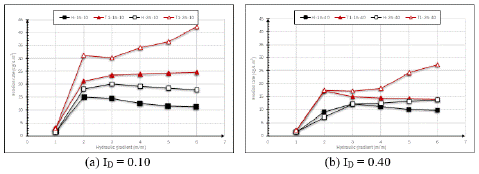
Figure 7: Erosion rate versus hydraulic gradient – type 1 heterogeneity.
These results can be explained by the fact that the heterogeneous specimens contain a significant content of erodible fines (75%) in the lower layer. Moreover, beyond a gradient of 3 m/m, the erosion rates of specimens H-15-40, H-25-40, T1-15-10 tend to stabilize. These results agree with those reported by Nguyen [13], who explains this by the clogging of the voids by fines, part of which participates in intergranular bonds (intergranular contact chain) which leads to a stabilization of the suffusion process.
Furthermore, a reduction in the erosion rate is observed for medium dense sand samples compared to very loose ones, this can be attributed to the reduction in pore space. However, type 1 heterogeneous samples remain more erodible than homogeneous ones.
Case of the Type 2 Heterogeneity: Figure 8 shows that for the first loading levels (gradient 1 to 2), the erosion rate increases more significantly for type 2 heterogeneous specimens than for homogeneous samples. This trend is reversed for high gradients (3 to 6) where a drop in the erosion rate is observed in the case of type 2 heterogeneous specimens. These results can be explained by the filtration effect of fine particles from the upper layer (ID = 0.1) by the lower layer (ID = 0.4) during the suffusion process of type 2 heterogeneous specimens. These observations were also made by Rochim [22] who investigated the filtration process in heterogeneous soils.
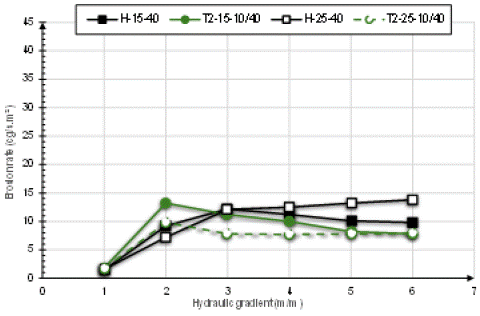
Figure 8: Erosion rate versus hydraulic gradient – type 2 heterogeneity.
Comparative Study of the Three Types of Specimens
Figure 9 presents the final erosion rates (hydraulic gradient i = 6 m/m) of the fines fractions for the two-density index ID = 0.1 and ID = 0.4.
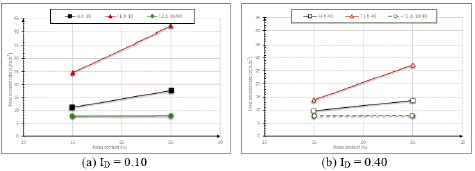
Figure 9: Final erosion rate versus fines content – hydraulic gradient i = 6 m/m.
The results (Figures 9a and 9b) show that type 1 heterogeneous specimens are more susceptible to erosion with the erosion rates varying from 14.4 cg/s.m² to 42.2 cg/s.m², against 9.8 cg/s.m² to 17.8 cg/s.m² for homogeneous specimens and 7.8 cg/s.m² to 7.9 cg/s.m² for heterogeneous type 2 specimens, for fines contents of 15% and 25%. A classification is obtained in terms of erodibility: T1-X-Y > H-X-Y > T2-X-Y. This can be explained as follows:
- Heterogeneity type 1 (T1): the large quantity of fines in the lower layer compared to the upper layer induces separation and easier migration of fine particles located downstream of the vertical flow.
- Heterogeneity type 2 (T2): suffusion is accompanied by more filtration and clogging of voids by fine particles, and makes erodibility more difficult (Benamar et al. [28]), the lower layer has a weaker porous network (reduced constriction).
Additionally, increasing the density index leads to a reduction in the erosion rate. This decrease in the erosion rate with the increase in the density index for all the specimens can be explained by densification, and the reduction in the void index. Erosion rates increase with the erodible fines content as shown by Fellag [18].
Conclusions
The objective of this study was to study the influence of granular heterogeneities on the process of internal erosion due to suffusion. Two configurations of heterogeneities were retained:
- Heterogeneity Type 1 (denoted T1): consisting of two soil layers with different fines content and the same density index.
- Heterogeneity Type 2 (denoted T2): composed of two layers with the same fines content and different density index.
- Homogeneous specimens were produced and studied to serve as reference samples.
The specimens were placed in a suffusion device and subjected to six hydraulic gradients (i = 1m/m to i = 6m/m). Sensitivity to suffusion and its consequences were analyzed based on measurements of the total eroded mass, erosion rate and flow velocity. The results showed that:
- The type 1 heterogeneity configuration is the most erodible of all the other configurations studied (homogeneous and heterogeneous type 2). For all the parameters studied (eroded mass, erosion rate and flow speed), heterogeneous type 1 specimens are more susceptible to suffusion, independently of the fines content and the density index;
- The erosion rate of the T1 specimens increases with the content of erodible fines;
- The erosion rate remains higher, with a slightly higher flow velocity for heterogeneous specimens compared to homogeneous specimens;
- The more the density index increases (reduction in the size of the constrictions formed by the granular skeleton), the more the rate of erosion decreases during suffusion;
- In the case of heterogeneous type 2 specimens, the susceptibility to suffusion is strongly linked to the content of erodible fines;
- Heterogeneous type 2 specimens are less erodible than homogeneous specimens;
- The comparative study showed a classification of the different configurations studied in terms of erodibility and axial deformation: T1 > H > T2. In general, the behavior of the specimens during the suffusion test is linked to the two control parameters, which are the fines content (Fc) and the density index (ID).
References
- M Foster, R Fell, M Spannagle. The statistics of embankment dam failures and accidents. Can Geotech J. 2000; 37: 5.
- C Irex. Erinoh: érosion interne dans les Ouvrages Hydrauliques: Méthodologie de reconnaissance et de diagnostic de l’érosion interne des ouvrages hydrauliques en remblai. Paris: PONTS CHAUSSEES. 2018: 2.
- R Fell, JJ Fry. Internal Erosion of Dams and Their Foundations. in Selected and Reviewed Papers from The Workshop on Internal Erosion and Piping of Dams and Their Foundations. Taylor & Francis. 2014: 3.
- LM Zhang, Y Xu, JS Jia, C Zhao. Diagnosis of embankment dam distresses using Bayesian networks. Part I. Global-level characteristics based on a dam distress database. Can Geotech J. 2011: 48: 1630-1644.
- E Vincens, KJ Witt, U Homberg. Approaches to determine the constriction size distribution for understanding filtration phenomena in granular materials. Acta Geotech. 2015; 10: 291-303.
- S Kowalczyk, M Maslakowski, P Tucholka. Determination of the correlation between the electrical resistivity of non-cohesive soils and the degree of compaction. J Appl Geophys. 2014; 110: 43-50.
- J Israr, B Indraratna, C Rujikiatkamjorn. Laboratory Investigation of the Seepage Induced Response of Granular Soils Under Static and Cyclic Loading. Geotech Test J. 2016; 39: 795-812.
- AW Skempton, JM Brogan. Experiments on Piping in Sandy Gravels. Geotechnique. 1994; 44: 3.
- RJ Fannin, R Moffat. Observations on internal stability of cohesionless soils. Géotechnique. 2006; 56: 497-500.
- DS Chang, LM Zhang. A Stress-controlled Erosion Apparatus for Studying Internal Erosion in Soils | ASTM Geotech Test J, ASME Digital Collection. Géotechnical Test J. 2011; 34: 6.
- L Ke, A Takahashi. Strength reduction of cohesionless soil due to internal erosion induced by one-dimensional upward seepage flow. Soils Found. 2012; 52: 698-711.
- A Rochim, D Marot, L Sibille, L Van Thao. Effects of Hydraulic Loading History on Suffusion Susceptibility of Cohesionless Soils. J Geotech Geoenvironmental Eng. vol. 143, p. 04017025, 2017; 143: 04017025.
- AD Nguyen. Etude expérimentale de l’impact de l’érosion par suffusion sur les propriétés physiques et mécaniques des sols. These de doctorat, Aix-Marseille. 2018.
- Y Luo, X Zhang, M Xiao. Influence of constriction-based retention ratio on suffusion in double-layered alluvial foundation with a cutoff wall. Soils Found. 2020; 60: 1489-1506.
- M Oueidat, A Benamar, A Bennabi. Effect of Fine Particles and Soil Heterogeneity on the Initiation of Suffusion. Geotech Geol Eng. 2021; 39: 2359-2371.
- Z Deng, X Chen, W Jin, G Wang. Effect of Gradation Characteristics and Particle Morphology on Internal Erosion of Sandy Gravels: A Large-Scale Experimental Study. 2023; 15: 2660.
- L Sibille, D Marot, Y Sail. A description of internal erosion by suffusion and induced settlements on cohesionless granular matter. Acta Geotech. 2015; 10: 735-748.
- R Fellag. Phénomènes d’érosion interne dans les graves et les sols grossiers: Application aux digues et aux barrages. phdthesis, Université Paris-Est. 2016.
- MJ Sulewska. Prediction Models for Minimum and Maximum Dry Density of Non-Cohesive Soils. Pol J Environ Stud. 2010; 19: 797-804.
- A Silviera. An analysis of the problem of washing through in protective filters. Proceedings of the 6th International Conference on Soil Mechanics and Foundation Engineering. 1965; 551-555.
- R Fell, JJ Fry. State of The Art on the Likelihood of Internal Erosion of Dams and Levees by Means of Testing. Erosion in Geomechanics Applied to Dams and Levees. John Wiley & Sons, Ltd. 2013; 1-99.
- A Rochim, D Marot, L Sibille, VT Le. Effects of Hydraulic Loading History on Suffusion Susceptibility of Cohesionless Soils. J Geotech Geoenvironmental Eng. 2017; 143: 7.
- LN Reddi, IM Lee, MVS Bonala. Comparison of Internal and Surface Erosion Using Flow Pump Tests on a Sand-Kaolinite Mixture. Semantic Scholar. Geotech. Test. 2000; 23.
- DS Chang, LM Zhang. A Stress-controlled Erosion Apparatus for Studying Internal Erosion in Soils. Geotech Test J. 2011; 34: 6.
- Z. Q. Zhou, P. G. Ranjith, et S. C. Li, « An experimental testing apparatus for study of suffusion of granular soils in geological structures », Tunn. Undergr. Space Technol., vol. 78, p. 222-230, 2018; 78: 222-230.
- SS Tomlinson, YP Vaid. Seepage forces and confining pressure effects on piping erosion. Can Geotech J févr. 2000; 37: 1-13.
- G Deng, LL Zhang, R Chen, L Liu, KX Shu, ZL Zhou. Experimental Investigation on Suffusion Characteristics of Cohesionless Soils along Horizontal Seepage Flow under Controlled Vertical Stress. Front Earth Sci. 2020; 8: 195.
- A Benamar, T Karoui, A Bennabi, A Seghir, HQ Wang. Influence of fine particles on internal erosion of sandy Soils. Environmental Science, Paris, France. 2012.